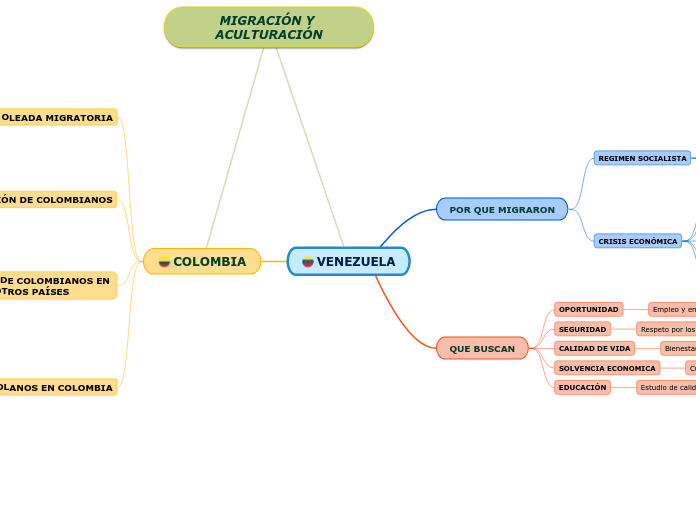MIGRACIÓN Y ACULTURACIÓN
VENEZUELA
In physics, energy is the quantitative property that must be transferred to an object in order to perform work on, or to heat, the object. Energy is a conserved quantity; the law of conservation of energy states that energy can be converted in form, but not created or destroyed
COLOMBIA
VENEZOLANOS EN COLOMBIA
Nuclear energy originates from the splitting of uranium atoms – a process called fission.
This generates heat to produce steam, which is used by a turbine generator to generate electricity. Because nuclear power plants do not burn fuel, they do not produce greenhouse gas emissions.
Write down the advantages and disadvantages of Nuclear Energy.
Mayormente están en Bogota, Cúcuta,
Barranquilla, Medellín y Cali
52% son hombres
48% son mujeres
44% población regular
56% población irregular
A 31 de Julio de 2020 hay registrados 1.7 millones de ciudadanos venezolanos
APORTES DE COLOMBIANOS EN
OTROS PAÍSES
A wind turbine, or alternatively referred to as a wind energy converter, is a device that converts the wind's kinetic energy into electrical energy.
Wind turbines are manufactured in a wide range of vertical and horizontal axis.
Write down the advantages and disadvantages of Wind turbines.
Los colombianos imparten y compartes su conocimientos en beneficio propio y de su lugar de residencia, destacándose sus habilidades artísticas, literarias, de diseño, investigación, tecnología, academia, liderazgo, desarrollo a la comunidad y obra social.
Comercio
Comunidad
Conocimiento
Cultura
MIGRACIÓN DE COLOMBIANOS
Solar energy begins with the sun. Solar panels are used to convert light from the sun, which is composed of particles of energy called 'photons', into electricity that can be used to power electrical loads.
Write down the benefits of using solar panels.
La población colombiana que radica en el exterior alcanza la suma de 4.7 millones de personas (más del 10% de la población) y residen es estos países
Mexico
Panamá
Australia
Estados Unidos
España
Venezuela
Canadá
OLEADA MIGRATORIA
Hydrogen fuel is a zero-emission fuel burned with oxygen.
It can be used in fuel cells or internal combustion engines.
Name the advantages and disadvantages of Hydrogen fuel.
A través de los años, Colombia ha acogido diferentes grupos de migrantes ciudadanos de países tan diversos al nuestro y con amplias diferencias marcadas como el idioma, la cultura, sus costumbres y su religión.
Japoneses
Judíos
Siria, Palestina y Jordania
QUE BUSCAN
There are many different types of energy, which all fall into two primary forms – kinetic and potential.
Energy can transform from one type to another, but it can never be destroyed or created.
EDUCACIÓN
Gravitational energy is a form of potential energy.
It is energy associated with gravity or gravitational force, in other words, the energy held by an object when it is in a high position compared to a lower position.
Give examples.
Estudio de calidad para niños y adolescentes
SOLVENCIA ECONOMICA
Chemical energy is stored in the bonds of atoms and molecules.
It is the energy that holds these particles together.
Stored chemical energy is found in food, natural gas, etc.
Give more examples.
Cubrir necesidades básicas
CALIDAD DE VIDA
Nuclear energy is stored in the nucleus of atoms.
This energy is released when the nuclei are combined (fusion) or split apart (fission).
Nuclear power plants split the nuclei of uranium atoms to produce electricity.
What element do they use to fuel nuclear power plants?
Bienestar social y comunitario
SEGURIDAD
Thermal energy is created from the vibration of atoms and molecules within substances. The faster they move, the more energy they possess and the hotter they become. Thermal energy is also called heat energy.
Give examples of heat energy.
Respeto por los DDHH
OPORTUNIDAD
Motion energy or mechanical energy is the energy stored in objects; as objects move faster, more energy is stored.
Examples of motion energy include wind, a flowing river, etc.
Give more examples.
Empleo y emprendimiento
POR QUE MIGRARON
Energy storage is the capture of energy produced at one time for use at a later time. A device that stores energy is generally called an accumulator or battery.
CRISIS ECONÓMICA
Thermal energy storage is achieved with widely differing technologies.
Depending on the specific technology, it allows excess thermal energy to be stored and used hours, days, months later, at scales ranging from the individual process, to building or town.
What are 3 types of thermal energy?
Aumento de la delincuencia
Desabastecimiento de alimentos
Falta de empleo
Falta de seguridad
Devaluación de la moneda
REGIMEN SOCIALISTA
Flywheel energy storage (FES) works by accelerating a rotor to a very high speed and maintaining the energy in the system as rotational energy.
Write down the main components of a typical flywheel.
Anarquía
Hiperinflación
Inestabilidad política









